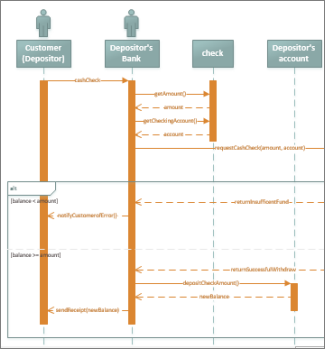

Used by actors when communicating with the system.describe the connections between the system and the environment that communicate.You can easily identify them when analyzing use cases. These objects could be any window, screen, dialog and menu, or other user interface in your system.

UML SEQUENCE DIAGRAM EXPLAIN SOFTWARE
Things we need to keep track of and storeīoundary objects (View) are objects that actors (e.g., users) communicate with in your software system.Describe objects that exist over time and are primarily concerned with persistent state.These could be database tables, Excel files, or “transient” sessions or cached data or something like that. What you see in the diagram above is that a web user initiates a query and generates an event that is processed by the controller to get the required information from the model, validate the information and pass the result set back to the view.Įntity objects (model) are nothing more than the information or data your boundary objects are looking for. Here is a simple and hypothetical sequence diagram for MVC. in his book Use Case-Driven UML Object Modeling. This model-view-controller can be best described visually using robustness analysis in stereotyped UML notation, which was first proposed by Ivar Jacobson in his award-winning book Object-Oriented Software Engineering (see references below) and further explained by Doug Rosenberg et al. The Model-View-Controller (MVC) pattern is a way of dividing an application into three distinct components the model, the view and the controller. Model-View-Controller (MVC) is a basic design pattern that separates the user interface logic from the business logic.


 0 kommentar(er)
0 kommentar(er)
